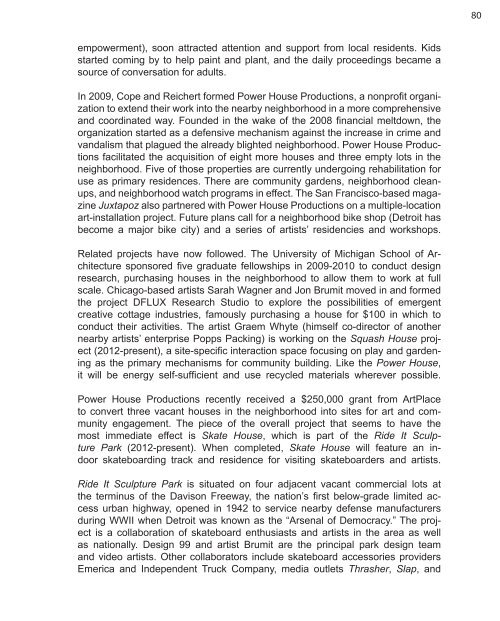Detroit Research Volume 1
You also want an ePaper? Increase the reach of your titles
YUMPU automatically turns print PDFs into web optimized ePapers that Google loves.
80<br />
empowerment), soon attracted attention and support from local residents. Kids<br />
started coming by to help paint and plant, and the daily proceedings became a<br />
source of conversation for adults.<br />
In 2009, Cope and Reichert formed Power House Productions, a nonprofit , a nonprofit organization<br />
to extend their work into the nearby neighborhood in a more comprehensive<br />
and coordinated way. Founded in the wake of the 2008 financial meltdown, the<br />
organization started as a defensive mechanism against the increase in crime and<br />
vandalism that plagued the already blighted neighborhood. Power House Productions<br />
facilitated the acquisition of eight more houses and three empty lots in the<br />
neighborhood. Five of those properties are currently undergoing rehabilitation for<br />
use as primary residences. There are community gardens, neighborhood cleanups,<br />
and neighborhood watch programs in effect. The San Francisco-based magazine<br />
Juxtapoz also partnered with Power House Productions on a multiple-location<br />
art-installation project. Future plans call for a neighborhood bike shop (<strong>Detroit</strong> has<br />
become a major bike city) and a series of artists’ residencies and workshops.<br />
Related projects have now followed. The University of Michigan School of Architecture<br />
sponsored five graduate fellowships in 2009-2010 to conduct design<br />
research, purchasing houses in the neighborhood to allow them to work at full<br />
scale. Chicago-based artists Sarah Wagner and Jon Brumit moved in and formed<br />
the project DFLUX <strong>Research</strong> Studio to explore the possibilities of emergent<br />
creative cottage industries, famously purchasing a house for $100 in which to<br />
conduct their activities. The artist Graem Whyte (himself co-director of another<br />
nearby artists’ enterprise Popps Packing) is working on the Squash House project<br />
(2012-present), a site-specific interaction space focusing on play and gardening<br />
as the primary mechanisms for community building. Like the Power House,<br />
it will be energy self-sufficient and use recycled materials wherever possible.<br />
Power House Productions recently received a $250,000 grant from ArtPlace<br />
to convert three vacant houses in the neighborhood into sites for art and community<br />
engagement. The piece of the overall project that seems to have the<br />
most immediate effect is Skate House, which is part of the Ride It Sculpture<br />
Park (2012-present). When completed, Skate House will feature an indoor<br />
skateboarding track and residence for visiting skateboarders and artists.<br />
Ride It Sculpture Park is situated on four adjacent vacant commercial lots at<br />
the terminus of the Davison Freeway, the nation’s first below-grade limited access<br />
urban highway, opened in 1942 to service nearby defense manufacturers<br />
during WWII when <strong>Detroit</strong> was known as the “Arsenal of Democracy.” The project<br />
is a collaboration of skateboard enthusiasts and artists in the area as well<br />
as nationally. Design 99 and artist Brumit are the principal park design team<br />
and video artists. Other collaborators include skateboard accessories providers<br />
Emerica and Independent Truck Company, media outlets Thrasher, Slap, and





